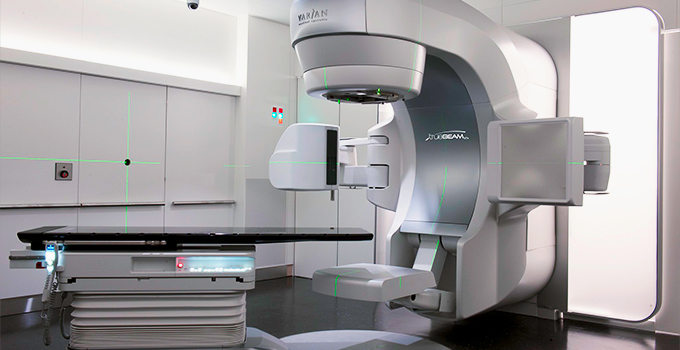OICR-supported scientists are pushing the boundaries of radiotherapy to help patients with the most complex cancers.
The future was uncertain for the first cancer patient to enroll in the SABR-COMET clinical trial.
It was 2012, and the OICR-supported study was one of the first randomized controlled trials to explore the use of stereotactic ablative radiotherapy (SABR) to treat patients with multiple metastatic lesions.
Metastasis is when cancer spreads from the original tumour to a different part of the body. It makes treatment more complex for patients and dramatically decreases their survival rates.
Facing a poor prognosis, that first patient put their hopes in SABR, a new and somewhat unproven form of radiotherapy.
SABR involves delivering high doses of radiation to the precise location of a cancerous lesion, as guided by advanced imaging tools. Up to that point, it had mainly been used to treat primary lung tumours.
But Dr. David Palma and colleagues at London Health Sciences Centre (LHSC) believed that SABR could make a difference for patients with metastatic cancers in all areas of the body.
“The question of whether SABR could treat metastasis was quite controversial at the time,” says Palma, a Radiation Oncologist at LHSC and OICR Clinician Scientist. “But we saw its promise and the potential to offer something more to our patients.”
Over the next four years, SABR-COMET recruited nearly 100 patients at sites across Canada, the Netherlands and Australia. Participants who received SABR ended up living an average of two years longer than those who didn’t. Some were even cured entirely, including that first participant from 2012, who was discharged 10 years later with no evidence of recurrence.
The results of SABR-COMET were so promising they have helped changed the perception of SABR among oncologists and patients, and contributed to an uptick in its use for metastatic cancer in Ontario and around the world.
They also inspired Palma and colleagues to keep pushing the envelope.
While the first SABR-COMET trial mostly treated patients with one to three metastatic lesions, subsequent trials have worked with patients whose cancer spread even further. Now, Palma and colleagues have launched a new randomized control trial using SABR to treat patients with more than 10 metastatic lesions.
“Over the years, we’ve become comfortable with using SABR to treat more and more complex patients,” Palma says. “And now we’re pushing the boundaries to try and help our patients live longer and better lives.”
***
Palma’s interest in SABR began in Amsterdam. There, he worked with SABR “pioneers” Dr. Suresh Senan and Dr. Ben Slotman as part of a fellowship that was partly funded by OICR. When he returned to Canada and began practising at LHSC in 2010, he was determined to further investigate the technique.
SABR offers a few advantages over other treatment options. The large dose of radiation can help treat tumours that are resistant to traditional radiotherapy. And because radiation is delivered to such a precise location, there is less risk of damage to surrounding tissue. That means patients often have minimal or no side effects from SABR, unlike with chemotherapy, which is often used to treat metastatic lesions.
SABR also has its limitations. Sometimes lesions are in locations that are right next to important structures, like the airway, and this can increase the risk of side effects. And the more lesions you treat, the more complex it is to plan and execute SABR.
But Palma and colleagues learned a lot from SABR-COMET about how to plan and execute treatment for multiple lesions, so they wanted to keep pushing.
***
They next tested SABR in patients with between four and 10 metastatic lesions. The OICR-supported SABR-COMET 10 enrolled more than 200 patients internationally, before wrapping up in 2023. Early results show SABR was feasible and safe for this population, with results on effectiveness expected shortly.
Then researchers launched the ARREST study in 2020, which would use push SABR even further to treat patients with more than 10 metastases. ARREST would be especially challenging because these patients are often unwell with a fast-progressing disease, leaving little time to plan and execute treatment.
Still, they were motivated to provide another option for this population, who may not be well enough to endure the side effects caused by other treatments.
The first ARREST study was led by Palma’s LHSC colleague Dr. Glenn Bauman, a Radiation Oncologist and Clinical Lead of OICR’s Clinical Translation program. Results were published recently in the Journal of Radiation Oncology, Biology, Physics, showing that SABR was feasible for patients with more than 10 metastases and caused limited side effects.
Armed with that knowledge, Bauman and Palma helped a junior radiation oncologist Dr. Timothy Nguyen launch the ARREST-2 randomized control trial earlier this year, hoping to see whether SABR can effectively treat such a large tumour burden. With support from OICR, patients are now being recruited in London, with plans to expand across the country.
While they know SABR may not reverse the prognosis of patients with such a high disease burden, they are hopeful ARREST-2 will help give patients a new, effective tool against metastasis.
“Even if we can’t cure their cancer, if we can give somebody another six months or another year of time with a high quality of life, then that’s immensely valuable for them,” Bauman says.
***
By helping expand the role of SABR in metastatic cancer, this research has already touched the lives of hundreds of patients over the past 12 years.
“SABR is now regarded as a standard-of-care option for people with limited metastatic disease, and the SABR-COMET studies really laid the foundation,” says Baumann.
Despite these advancements, Palma says there is still plenty of work to be done – especially for patients with complex metastatic disease.
“It’s important to keep innovating for patients,” he says. “There is always more we can do, whether it’s helping someone manage their symptoms or helping them live longer.”
Palma credits his colleagues for the amazing collaborations along the way. He is also grateful to OICR for supporting his research for more than a decade through the Institute’s Investigator Awards program.
He says funding from OICR helped him get the SABR-COMET research off the ground, and he was able to leverage it to grow the program.
“The support I have received from OICR not only lit the spark for my research, but it also kept it burning for all these years,” Palma says.



